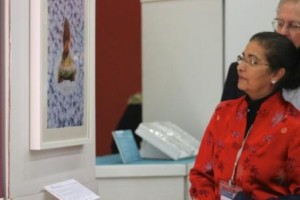By Michael Baggot
The Second Bioethics Art Competition of the UNESCO Chair in Bioethics and Human Rights held its inauguration ceremony in Hong Kong at the Gallery by the Harbour of the Harbour City Shopping Mall on December 7, 2013.
“Through the universal language of art, our competition reaches not only those who study bioethics in the classroom, but all people” announced UNESCO Chair Director Alberto Garcia.
The 15 winning art pieces of the international competition were exhibited during the UNESCO Chair Bioethics, Multiculturalism and Religion Conference at Hong Kong Baptist University, before moving to the Harbour City Gallery. The exhibition is slated for display in the New York United Nations Headquarters, Rome, Houston and Mexico City in 2014.
“These impressive works of art, if used as tools for teaching bioethics in Hong Kong, would contribute significantly toward the multi-disciplinary learning experience of students.” observed Dr. Vivian Taam Wong, one of the competition’s Hong Kong-based judges.
In 2012, artists were invited to “create an image, with respect for all cultures and religions that speaks to the impact of life sciences for present and future generations.” In short, participants were given creative liberty to visually “illustrate love, compassion and care” in accord with articles 12 and 16 of the Universal Declaration of Bioethics and Human Rights.
“The use of visual art, which transcends languages and ethnic as well as other traditions, remains a most effective platform for increasing communication and understanding among racial, religious and age groups.” added Dr. Lam Man Kit, another Hong Kong-based judge.
The competition is fruit of the UNESCO Chair’s conviction that the mission of fostering the art of convergence and cooperation in global ethics is a universal mission that entails the participation of individuals from all backgrounds and professions.
“Drawing from so many cultures allows those who see the works to get a better understanding of how people in other places experience vulnerability, ask questions about life, express compassion, and challenge minds and medicine.” added American judge Dr. Colleen M. Gallager.
The competition was divided into the categories of Fine Arts, Photography and Student Art (ages 13-17), with a Best of Show and four other winning pieces for each category. Artists from 18 different countries submitted work to an international panel of 10 judges.
An image of the winning works and a brief explanation of the piece from the respective artist can be seen on the competition’s official page.
In the category of Fine Arts, the Best of Show was Giovanni Gasparro, with Eric Carson, Andrea Colella, Carmelo Maria Carollo, Giacomo Rizzo as additional winners. In the category of Photography, the Best of Show was Ben DeSoto, with Joni Kabana, Barbara Doran, Jerry Galea, Carlo Paluzzi as additional winners. In the category of Student Art, the Best of Show was Ka Wun Cheung, with Eileen Hwang, John McCabe, Emma Meyler, Theresa Reed as additional winners.
According to article 12, “The importance of cultural diversity and pluralism should be given due regard. However, such considerations are not to be invoked to infringe upon human dignity, human rights and fundamental freedoms, nor upon the principles set out in this Declaration, nor to limit their scope.”
According to Article 16, “The impact of life sciences on future generations, including on their genetic constitution, should be given due regard.”
In 2011, the First Bioethics Art Competition Exhibit was unveiled in the UN Headquarters in New York City. The competition received 225 submissions from 23 countries by 132 artists reflecting upon the need to “Respect Human Vulnerability, Personal Integrity, Cultural Diversity and Pluralism.”
Yvonne Denbina, Chair of the Bioethics Art Competition, explains that the competition originated from a conversation with UNESCO Chair Director Alberto Garcia and Chair Fellow Fr. Jospeh Tham, LC regarding the role of art in bioethical discourse.
“I thought that a competition focused on bioethics could be an activity that would appeal to many artists. The challenge was to gather interested individuals, then to create a vision and a statement to inspire artists to reach into their own hearts. From the heart of the artist would spring the images that would move and touch others, viewers of their creations. This could be the way to link bioethics to art.” said Denbina.
Denbina is already working with her international staff to prepare the third Bioethics Art Competition and expects to incorporate an even wider range of artist medium, including film.


